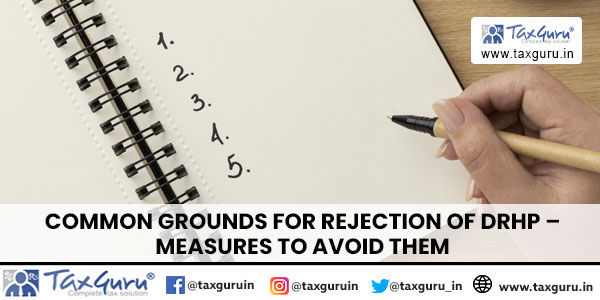Introduction
When a company looks to raise capital through a public offering, the Draft Red Herring Prospectus (‘DRHP’) is a crucial document that must be submitted. Securities and Exchange Board of India (‘SEBI’)’ (Framework for Rejection of Draft Offer Documents) Order, 2012 stresses the importance of clear and complete disclosures, in line with Schedule VI of the SEBI ICDR Regulations, 2018 to ensure investor protection. There are circulars/ guidance issued by SEBI and stock exchanges regarding drafting of DRHPs[1].

However, many DRHPs face rejection due to common issues like incomplete disclosures, non-compliance with regulations, or unclear risk information, all of which can prevent investors from fully understanding the offering. In this article, we’ll look at these common reasons for rejection and offer some practical tips on how to avoid them, helping companies navigate the approval process smoothly.
Reasons for rejection of DRHPs
The key reasons and criteria why DRHPs are rejected, based on regulatory guidelines and common compliance issues are listed in the table below:
| Title | Criteria/Details |
| Criteria for Rejection of DRHP | – Capital structure issues:
a. Existence of circular transactions for building up capital or net worth of the issuer. b. Unidentified promoters. c. Discrepancies in promoter contributions as compared to provisions of SEBI (ICDR)
|
| – Unclear objectives of the issue:
a. DRHPs with vague fund utilization plans: b. Unjustified spikes in working capital needs[2]: Bombay Stock Exchange [‘BSE’] in case of an SME IPO had sought clarification highlighting that during the forecast period there was lower working capital requirement as compared to working capital requirement prior to forecast period. c. Incomplete project groundwork: In an IPO company had stated that they were planning to utilise funds raised through IPO in setting up a factory and for purchase of plant and machinery. On further evaluation it was found that the company has not purchased the land till now for setting up of factory. |
|
| – Complex or exaggerated business models:
Misleading or overly complex models create difficulty in evaluating risks, which can result in rejection. |
|
| – Inconsistent financial statements:
a. Sudden increases in income or profits without justification: A sudden surge in business just before filing the draft offer document, especially in key financial metrics like income, profits, debtors, creditors, or intangible assets, may raise concerns. If the company’s explanation for this spike is unsatisfactory, it could be scrutinized further. b. Qualified audit reports, and improper accounting standards are flagged as concerns: If auditors raise concerns about accounting policies in their reports, it applies not only to the issuing company but also to key subsidiaries, joint ventures, and associates that significantly impact its business. This scrutiny also extends to entities where IPO funds will be utilized. |
|
| – Pending litigation or regulatory action:
a. Major unresolved lawsuits: If the company is proposing an IPO and it has been levied a penalty, or its senior management has been levied a penalty by any regulatory authority then SEBI raises concerns in clearing IPO. b. Regulatory investigations: c. Material issues that are concealed or undisclosed lead to rejection: In a recent matter of Trafiksol Ltd SEBI stalled the IPO of the company as the details provided by it in their objects of the issue regarding purchase of software valued at Rs 17.70 crore from a vendor which had questionable financials and failed to file its annual financial statements with the Ministry of Corporate Affairs (MCA). SEBI has asked the company to return the money to the investors[3]. |
|
| – Non-compliance with laws:
a. Violations of ICDR Regulations or companies Act provisions, or insufficient documentation can result in rejection: SEBI has highlighted companies act 1956 violation in case of issue of shares to more than 50 employees of HDB Financial services. This is alleged to be in violation of Companies act 1956 and required SEBI approval for public issue then.[4] |
Consequences of rejection
In case of rejection of DRHP by SEBI, minimum cooling-off period of 6 months will have to be kept for resubmission of rejected DRHPs. Further for rejected DRHPs no refund of filing or processing fees will be given to the company. Resubmission of draft offer documents is permitted only after addressing the insufficiencies highlighted by SEBI.
Conclusion
An Initial Public Offering (IPO) is a crucial way for companies to raise funds, but it comes with extensive compliance and disclosure requirements. Since investors rely on the DRHP for key information before making decisions, companies have both a legal and ethical duty to ensure accuracy. Preparing for an IPO and drafting the DRHP is a time-consuming and costly process. If the DRHP gets rejected, it leads to wasted time and financial loss. To prevent this, companies must strictly follow the rules and regulations which will make the process easier.
Reference
[1] https://taxguru.in/sebi/bse-guidance-merchant-bankers-preparation-offer-documents.html
https://taxguru.in/sebi/sebi-guidelines-returning-draft-offer-document-resubmission.html
[2] file:///C:/Users/hasti/Downloads/Merchant%20Banker%20Reply__Working%20Capital.pdf
[3] https://www.sebi.gov.in/enforcement/orders/dec-2024/order-in-the-matter-of-trafiksol-its-technologies-ltd_89239.html
[4] https://www.business-standard.com/finance/news/hdb-financial-services-regulatory-hurdles-1-5-billion-ipo-plans-125012300298_1.html




